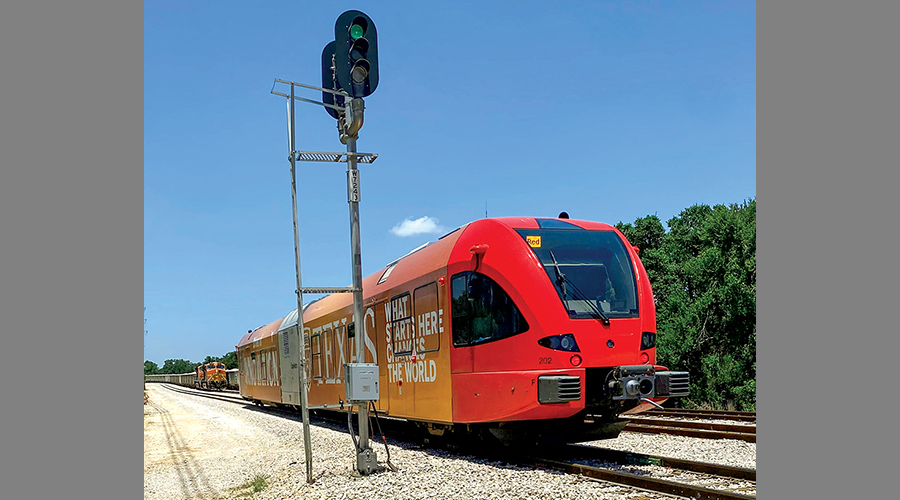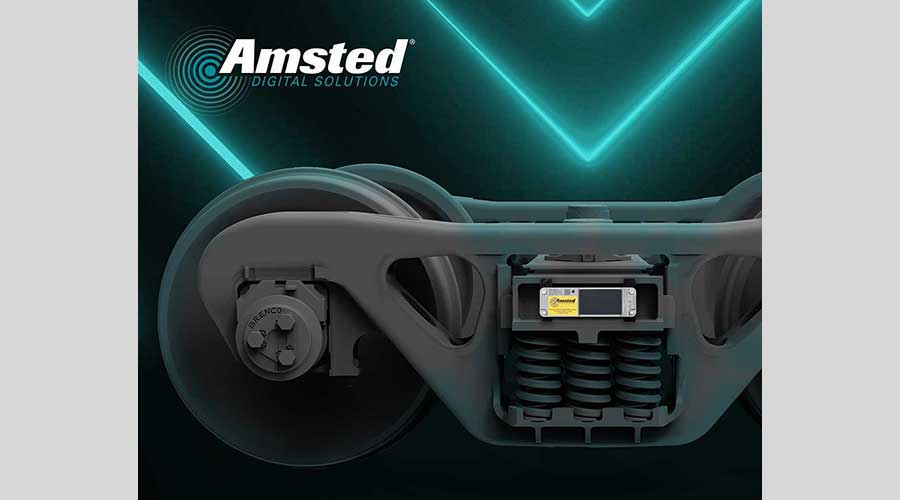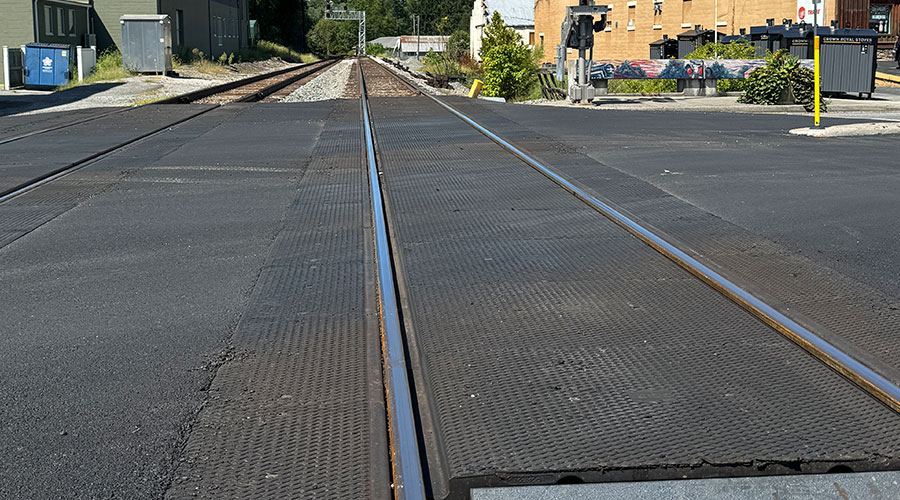Stay updated on news, articles and information for the rail industry
October 2009
Rail News: C&S
Multi-functional, integrated platforms will provide railroads more control over trains and other dispatching and C&S tasks, suppliers say
By Jeff Stagl, managing editor
Despite today's high-tech and automated signaling systems, which run the gamut from positive train control (PTC) to centralized traffic control (CTC) to automatic block signaling, railroads continue to rely on dispatchers and dispatching systems to safely monitor and control train movements.
They also count on employing systems that offer more functions and fewer components to control trains efficiently and affordably.
"Railroads need a system that offers all types of functionality and in one centralized platform," says Giampaolo Orrigo, product line manager for Ansaldo STS USA Inc.'s dispatch systems. "You then need less hardware and software."
In addition, some railroads — especially a number of regionals and short lines — turn to service providers to meet their dispatching needs and eliminate overhead expenses associated with purchasing and maintaining systems. Those roads also are seeking more bang for their dispatching buck and are leaning on providers to offer more value-added services.
Whether they're a system supplier, service provider or software developer, companies involved in the dispatching realm are taking railroads' demands to heart by striving to develop systems and services that up the rail traffic-control ante.
When it comes to raising the dispatching stakes, Chicago is top of mind for railroads. Trains sometimes need two to three days to cross the Windy City because they have to pass through numerous interlockings and most dispatching functions are conducted by phone. Enter Ansaldo STS USA.
A common understanding
For the past several years, the company has been developing the Common Operational Picture (COP), a Web-based platform designed to tie in all computer-aided dispatching (CAD) systems maintained by freight and passenger railroads operating in Chicago. To be offered as a Software-as-a-Service, COP will provide dispatchers a common view of all trains in Chicago and speed traffic by eliminating phone dispatching, says Ansaldo STS USA's Orrigo.
"We believe it will save 65 percent in terms of time," he says.
In November, the Chicago Transportation Coordination Office — which includes members of every railroad operating in the Windy City and oversees rail traffic in the region — will obtain COP software under a three-year contract as part of the platform's second phase. The office then will begin using the software, while the various railroads will do so "at their own discretion," according to Ansaldo STS USA.
BNSF Railway Co., CSX Corp. and Union Pacific Railroad already have been using a COP working prototype for some time, says Orrigo.
Ansaldo STS USA also is working with UP to implement the Maestroª dispatching platform for the Class I's next-generation CAD-X system. Last year, Ansaldo STS USA finished installing Maestro as the dispatching platform for CSX's entire network, says Orrigo, adding that UP's system is projected to enter revenue service in 2011.
"Maestro also has an application for most commuter railroads, like Metra," he says.
In addition, Ansaldo STS USA is working with the Alaska Railroad Corp. on the first application of Maestro with a vital PTC system, and seeking to win New York Metropolitan Transportation Authority's proposed contract to centralize train control for MTA Long Island Rail Road and MTA Metro-North Railroad. The train control plan is included in the authority's recently proposed five-year budget, says Orrigo.
"We have an advantage because we just got a PATH contract for a control system," he says, referring to a $24.7 million contract Ansaldo STS USA won this summer from New York's Port Authority Trans-Hudson Corp.
From many to single system
The company will centralize PATH's communication network into a single, fully integrated system that will include CTC; supervisory control and data acquisition (SCADA); closed-circuit televisions; and integrated voice communications.
The system will based on Ansaldo STS USA's Hermes platform, which features advanced routing algorithms and can be integrated with security, passenger information, voice telecommunication and enterprise management systems.
Available since the early 2000s, the Hermes platform currently is used by the Port Authority of Allegheny County and Charlotte Area Transit System.
"The strength of the system is regulating the schedules of various trains," says Orrigo, adding that Ansaldo STS is working on seven projects in China to supplement communications-based train control (CBTC) systems with the Hermes platform.
Integration the intent
Invensys Rail/Safetran Systems also is integrating various systems — from CBTC to the European Rail Traffic Management Systems to remote data collection systems — with dispatching systems to help railroads overseas boost efficiency. Recent projects include Beijing's Line 5 and Shanghai's Line 10 in China, Singapore's downtown line, and a train control and management system in Melbourne, Australia.
In North America, Invensys Rail recently expanded a dispatching system for Vancouver's Canada Line, which will host the 2010 Winter Olympics.
In the United States, the PTC deployment push presents opportunities to provide the necessary platform to integrate a new PTC system with an existing dispatching system — a lower-risk alternative to modifying an existing system to add PTC signaling, Invensys Rail officials said in an email.
The company is field testing new dispatch systems that feature train communications and PTC technologies already in service on two freight railroads to communicate movement authorities and train position in real time. The systems would help railroads boost operational efficiency at a low cost, Invensys Rail officials said.
The company is relying on its expanded portfolio from the Safetran and Quantum Engineering subsidiaries, and SystematICS Control platform to further its concept of total integration of subsystems onto one platform.
The concept would provide operational staff a common Graphical User Interface and better awareness, and improve the coordination of actions on both freight- and transit-rail systems, Invensys Rail officials said.
"The benefits of integration are most seen in transit applications, where multiple subsystems such as signaling, power traction, environmental control, passenger information, CCTV, security, fare collection, station management, etc., can be seamlessly integrated," they said. "These include reduction in incident management time and the ability to coordinate all the subsystems so passengers can be informed and moved efficiently/quickly through the rail network."
A winning combination
RailComm also offers a system that enables transit agencies to combine train control with a means to interface with, report on and control various other devices. The SCADA system is part of the company's Domain Operations Controller (DOC¨) software.
For example, MTA New York City Transit uses SCADA to control third-rail and switch heaters, while Austin, Texas' Capital Metro uses the system at more than 70 grade crossings to record any events, says RailComm President and Chief Executive Officer Joe Denny.
The company also offers DOC:CTC, a CAD dispatching system designed to automate dispatching functions for mainlines in dark or signaled territories.
"The system's domain engineering architecture allows us to reuse code base," says Denny. "It's considered an off-the-shelf system and can be configured to how you want to use it."
Launched in 2000 on the New England Central Railroad, DOC:CTC recently was accepted by Capital Metro for use in dark territory. Iowa Northern Railway and Mexico's Ferrosur S.A. de C.V. also use the system in dark territory, while the Tri-County Metropolitan Transportation District of Oregon, Northern Indiana Commuter Transportation District (NICTD), Music City Star, Buckingham Branch Railroad, Lake State Railroad, Genesee & Wyoming Inc. and RailAmerica Inc. use DOC:CTC in signaled territory.
Currently, RailComm is working with the Regional Transportation District of Denver to replace a GE dispatching system with DOC:CTC, says Denny.
"It will have the look and feel of the GE system so operators don't have difficulty adjusting to the new system," he says.
Calling all customers ...
Meanwhile, Penta Corp. is beginning to line up rail customers for a voice dispatching console the company has been developing the past few years. Introduced earlier this year, the new-generation, voice-over-IP cPCx is a modern telecommunication system that uses open architecture, says Penta Director of Sales and Operations Bobby Chandler. The system can be sized from 24 to 4,000 ports.
"If you have a proprietary system and need to make changes, the architecture has to be changed," he says. "Railroads are going to more broadband. We push this system now for all railroads."
Penta also offers a PCx voice dispatching console for smaller applications; MNx console for small dispatch centers, yards and maintenance facilities; and SLx console for a single, self-contained PC-based dispatch system. By year's end, the company expects to install cPCx at a new control center for Toronto's GO Transit, which earlier this year merged with Metrolinx. The system will be cutover in early 2010.
For now, Penta continues to enhance cPCx's console so the system can be custom controlled and its screen can be tailored to a customer's needs, says Chandler.
American Rail Dispatching Center Inc. (ARDC) also is trying to attract additional rail customers. The firm's owner, Fortress Investment Group L.L.C., recently decided to resume outsourcing its services. A RailAmerica subsidiary, ARDC first outsourced its services from 2003 until Fortress acquired the holding company in late 2006.
In mid-September, ARDC will begin providing rail traffic control services for Grenada Railway L.L.C. and Natchez Railway L.L.C., which were formed earlier this year after the short lines' owners purchased Mississippi lines from CN. ARDC continues to provide dispatching services to 31 RailAmerica short lines and Southwestern Railroad Inc. in Carlsbad, N.M.
The company's services target regionals and short lines, which otherwise would need to buy expensive computer systems — perhaps costing $500,000 — to control their own traffic, says ARDC Director Tom Murphy.
"Short lines don't have the tools of a Class I — we can provide those tools," he says. "The challenge is convincing old-time railroaders that outsourcing is a good thing to do. Most of them believe they need to hear it, feel it and smell it when it comes to dispatching."
ARDC currently operates six workstations and is licensed to operate seven, says Murphy. The company's dispatching system can quickly adapt logic to ensure switches on mainlines are properly aligned or to comply with new hours-of-service regulations, he says.
"We can virtually do it overnight," says Murphy.
On the cusp
It'll take Innovative Scheduling longer to develop its train dispatching software. The decision-support system and software developer expects to complete R&D in about one year.
Initially, the automated software/system will target dispatching of low-density corridors, or those predominantly operated by regionals and short lines. Innovative Scheduling will need about two years to develop software for Class Is' high-density corridors, says President and CEO Ravindra Ahuja.
Current dispatching systems are manual, auto-pilot-type ones that don't entirely meet railroads' business needs, and stay two steps ahead of train movements instead of perhaps 10, he says.
"We want to bring optimization to line of road to minimize train delays," says Ahuja. "Velocity is the No. 1 focus of line of road, and reliability is important, as well."
Innovative Scheduling is seeking an R&D partner to help hasten the development of algorithms and advance software testing, he says. The company also is trying to obtain financing.
Ensuring railroads have optimal dispatching options as soon as possible remains goal No. 1 for all system suppliers and service providers.
"The key demand we are seeing from freight and transit railroads is how to get the most efficiency from the railway asset," Invensys Rail officials said in an email. "The dispatching system plays a key part in achieving efficiency saving in terms of on-time running, reduced costs or increased capacity." To achieve these goals, the dispatching system needs access and control of the trains and other subsystems, whether freight or transit." 


 2025 MOW Spending Report: Passenger-rail programs
2025 MOW Spending Report: Passenger-rail programs
 Gardner steps down as Amtrak CEO
Gardner steps down as Amtrak CEO
 Guest comment: Oliver Wyman’s David Hunt
Guest comment: Oliver Wyman’s David Hunt
 Women of Influence in Rail eBook
Women of Influence in Rail eBook
 railPrime
railPrime







